Protecting the world's infrastructure with rope access technology
Protecting the world's infrastructure with rope access technology

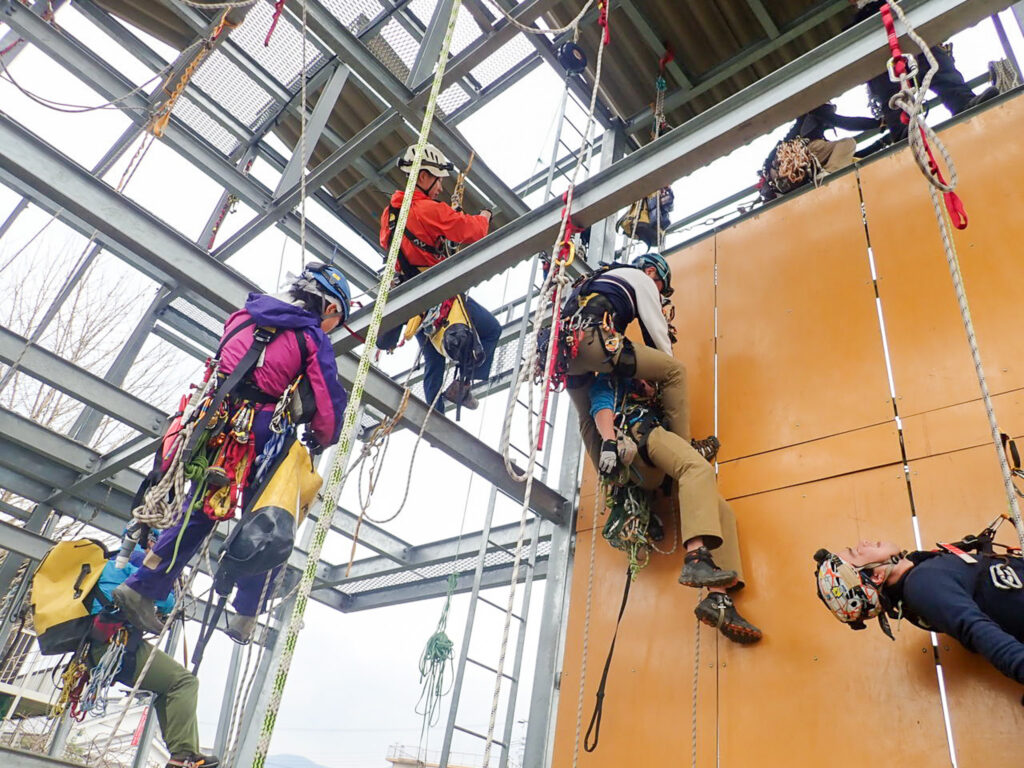
Rope access technique, as the name suggests, is a technique for accessing (high or difficulty locations) using ropes, which spans diverse applications including tree climbing, window cleaning, rock climbing, and slope construction work.
Among these, the technique that can be utilized for surveys and inspections such as bridge slope surveys is Rope Access Technique [SORAT], which was developed by Keystone and is being promoted by the Society of Rope Access Technique (abbreviated as SORAT).
Thge roots of Rope Access Technique [SORAT] lie in cave exploration technique (commonly known as SRT) developed in Europe and America. The Keystone staff, led by cave explorer Osamu Seki, developed and improved it for application to survey and inspection work in Japan
With Rope Access Technique [SORAT], rope users (rope workers) can move freely in all directions using one or multiple ropes, providing [SAFE], [RAPID], and [RELIABLE] access to any high or difficult location to conduct visual inspections and surveys.
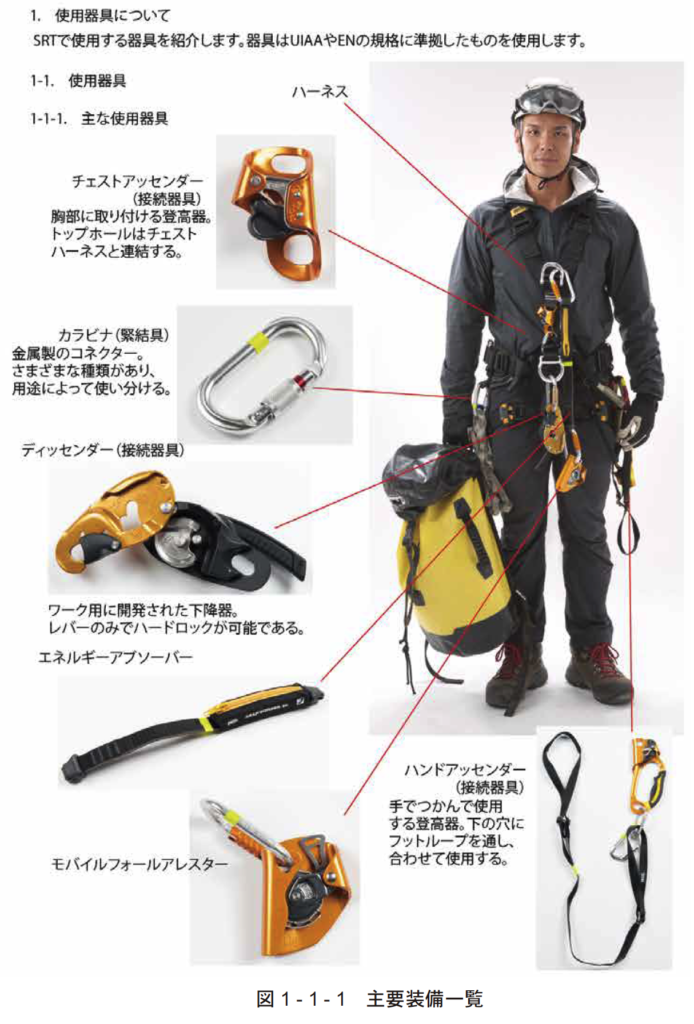
The equipment used in rope access technique is almost entirely manufactured overseas and complies with UIAA or EN standards, amking it highly reliable. Most items are made of metal (aluminum) or fiber, designed to maintain high strength while being lightweight.
The rope used are a type called semi-static ropes, which are thin (approximately 8mm to 12 mm in diameter) yet flexible, capable of withstanidng loads of about 2 tons, providing stregth equivalent to standard safety lines.
The difference between these and rock climbing ropes (dynamic ropes or mountaineering ropes) lies in their elasticity. Unlike dynamic ropes, which have sufficient elasticity to absorb impact during falls, semi-static ropes are designed to stretch only slightly when loaded.
Rope length vary from 20m to 100m, used according to specific situations. They are stored in rope bags for carrying and the neccessary length is pulled out as needed.
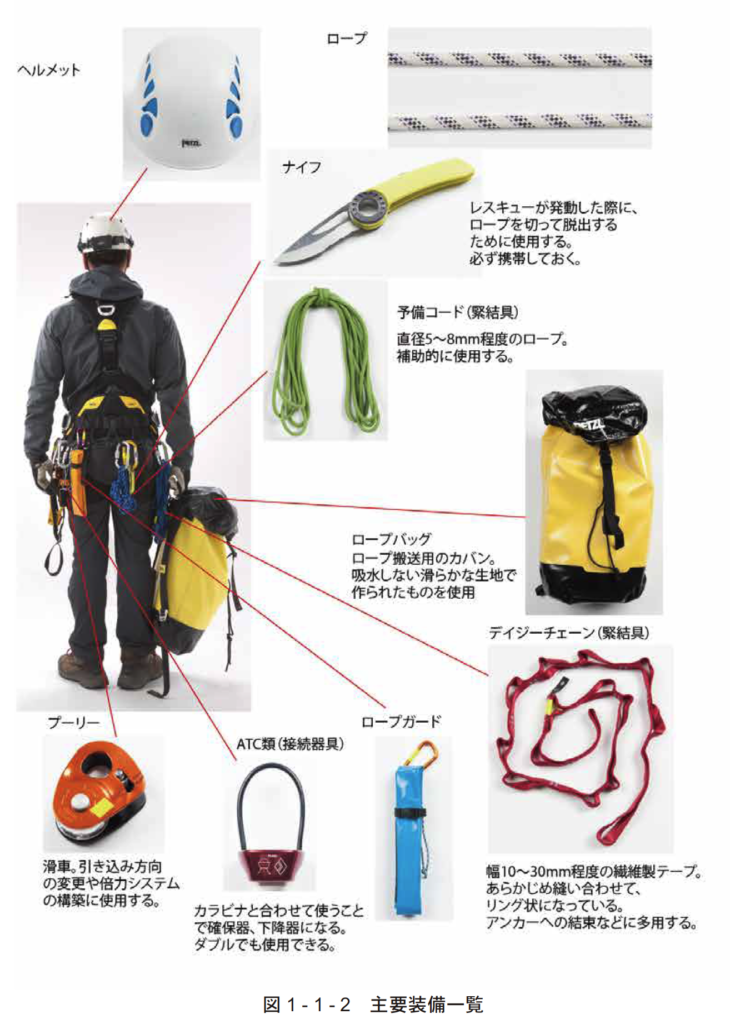
Ascending and decending devices can be broadly categorized into descenders and ascenders. The RIG is commonly used as a descender, while hand ascenders and chest ascenders are combined for ascending.
Protective helmets are similar to those used in rock climbing and must never come off regardless of movement or body position.
Safety harnesses are full-body harnesses, some specifically designed for rope access technique. Users select ones that fit their bodies properly and wear them correctly. Including all other equipment, the complete set weighs about 10kg and costs approximately 100,000 yen.
In principle, all equipment is personally owned and managed. Rope workders (rope users) purchase their own equipment, take personal responsibility for its maintenance, and burrowing or lending is out of the question.
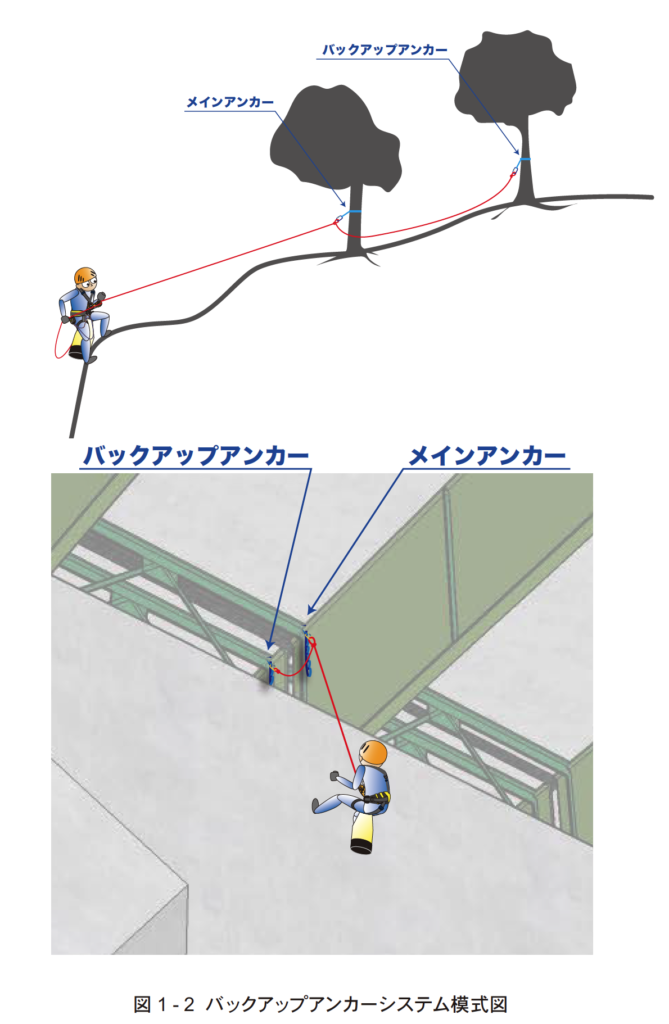
Rope are securely fastened to two different sturdy supports (anchor points), and depending on the method of attachment, there are systems such as back anchor systems and shared anchor systems, which are chosen based on the positional relationship between the two anchor points.
This is a system where two anchor points are designated as the main anchor and the backup anchor. Normally, all loads (the rope worker’s body weight and other weights) are placed on the main anchor. In case the security at the main anchor is lost due to detachment or other issues the load transfers to the backup anchor, preventing a fall.
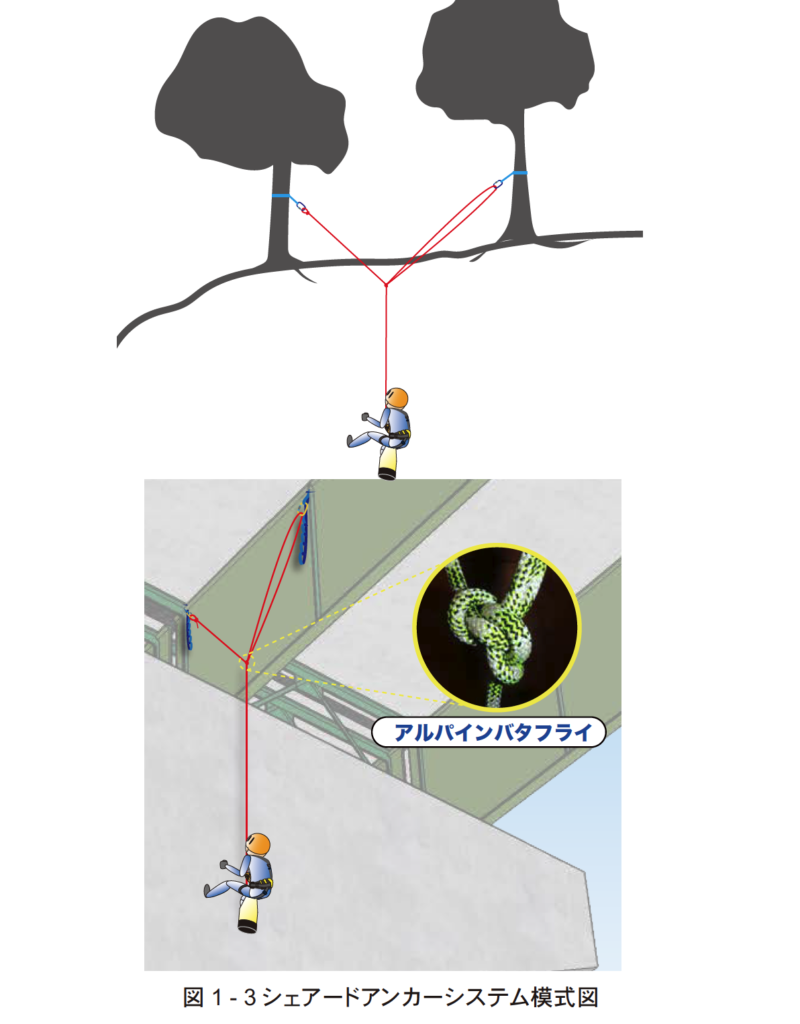
This is a system where the load is distributed between two anchor points. It is also called Y belay because of its Y-shaped configuration. The ‘Alpine Butterfly’ include its ability to distribute the load and minimize the strength loss that occurs when creating a knot.
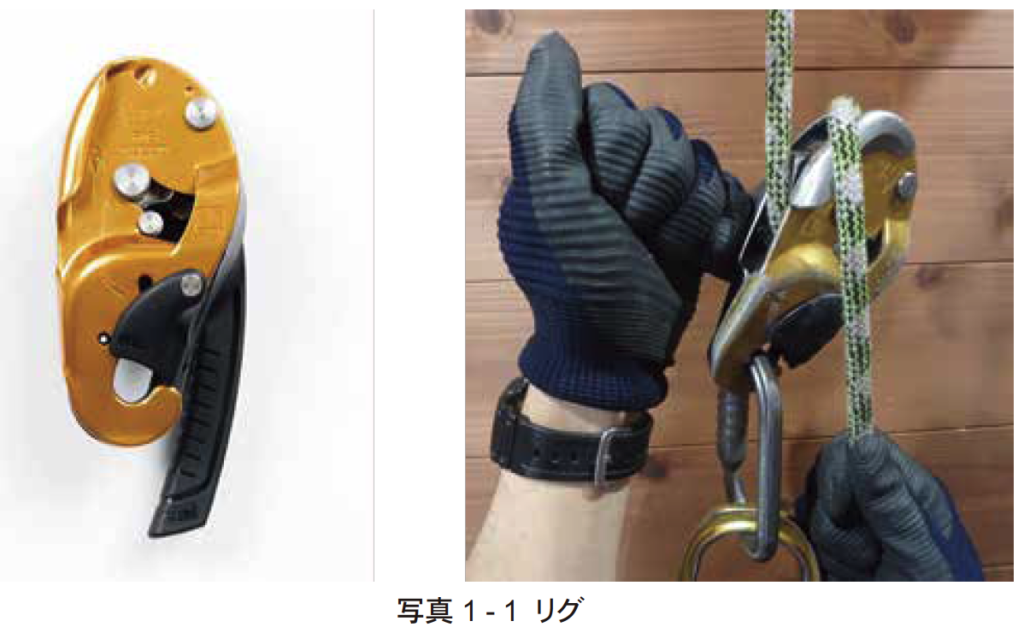
There are numerious gears for descending on ropes, each with various characteristics. In rope access, an inline-type descender that doesn:t cause kinks (twists) in the rope and has an auto-stop function is required. PETZL’s RIG is often adopted (Photo 1-1)
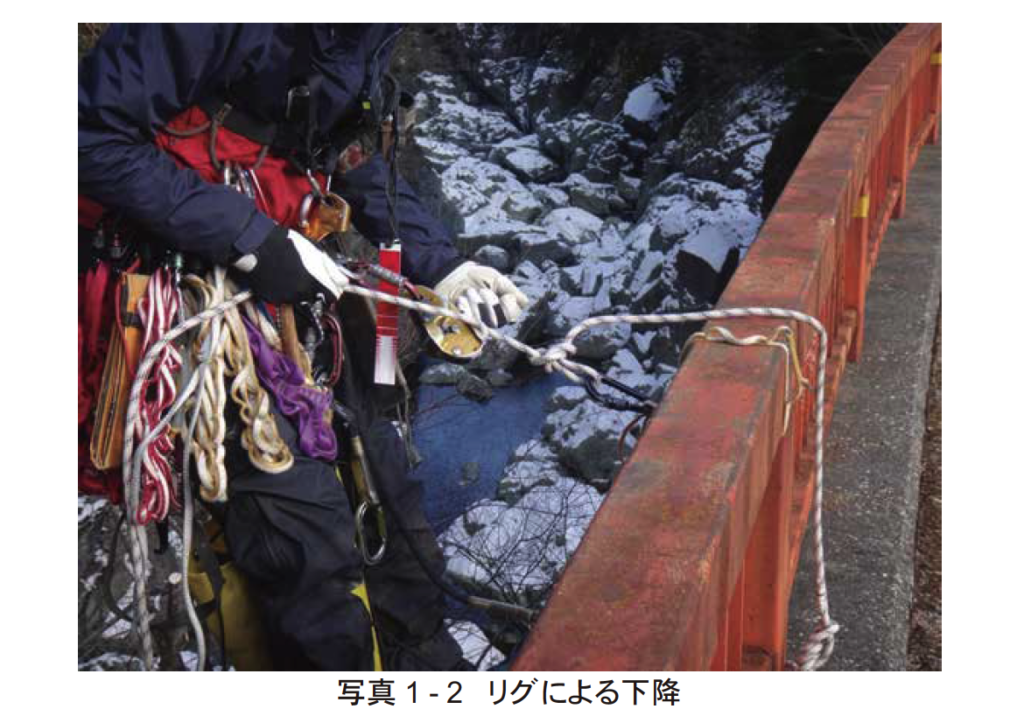
The RIG locks by rotating a cam through friction with the rope, pinching the rope between the cam and the bobbin
Hold the lever with your left hand and the rope with your right hand. Move the lever counterclockwise to gradually release the friction and descend. It is crucial never to let go of the brake-side rope with your right hand. If you operate the lever without holding the brake-side rope, you will enter a free-fall state and drop.
Additionally, if the descent speed is too fast, high heat can be generated from the friction between the descender’s bobbin and the rope, potentially melting the rope’s sheath. A guideline is to take about 2 seconds to descend 1 meter.
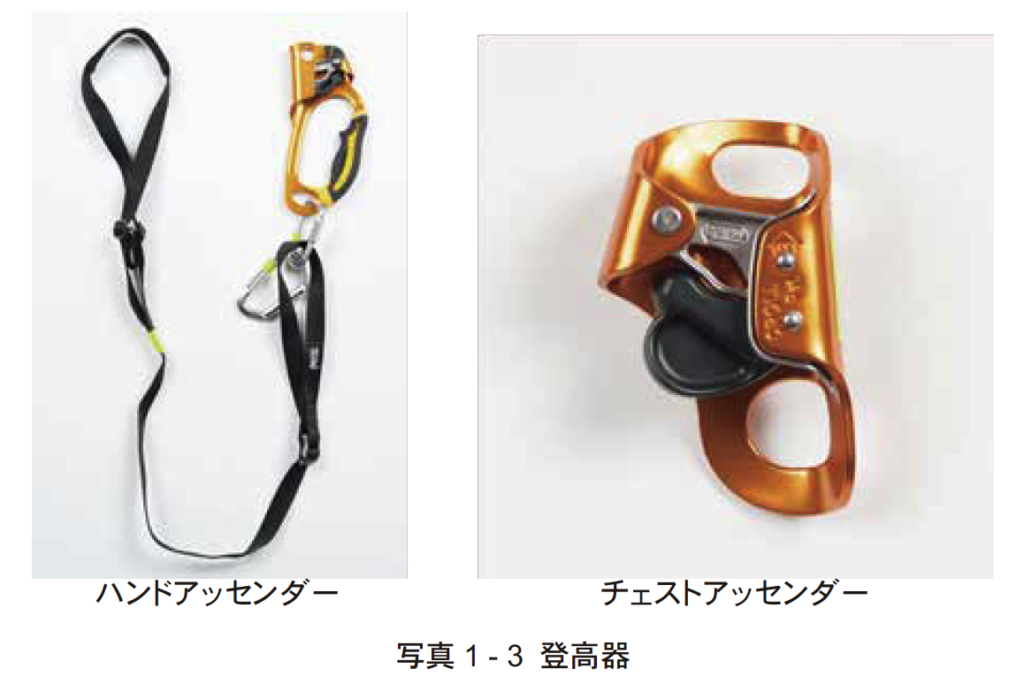
There are several types of rope ascending systems using ascenders, and among them, rope access technique adopts systems suitable for vertical or aerial movement and staying in position.
A combination of a handled ascender and a chest ascender is used (Figure 1-3, Hand Ascender and Chest Ascender).
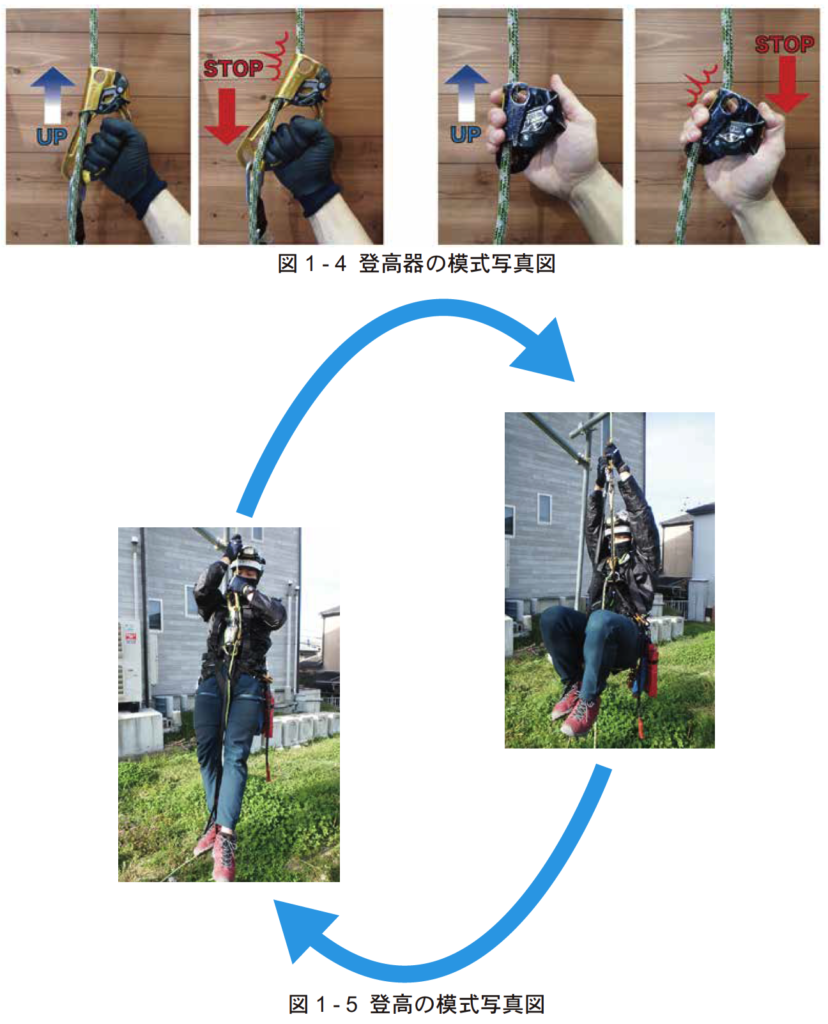
The ascender locks by having the cam’s teeth bite the rope, pinching it between the teeth and the frame. The rope can slide upward, but when pulled downward, the brake engages (Figure 1-4).
After setting the equipment on the rope, always confirm that it locks by pulling it in the direction where the load will be applied.
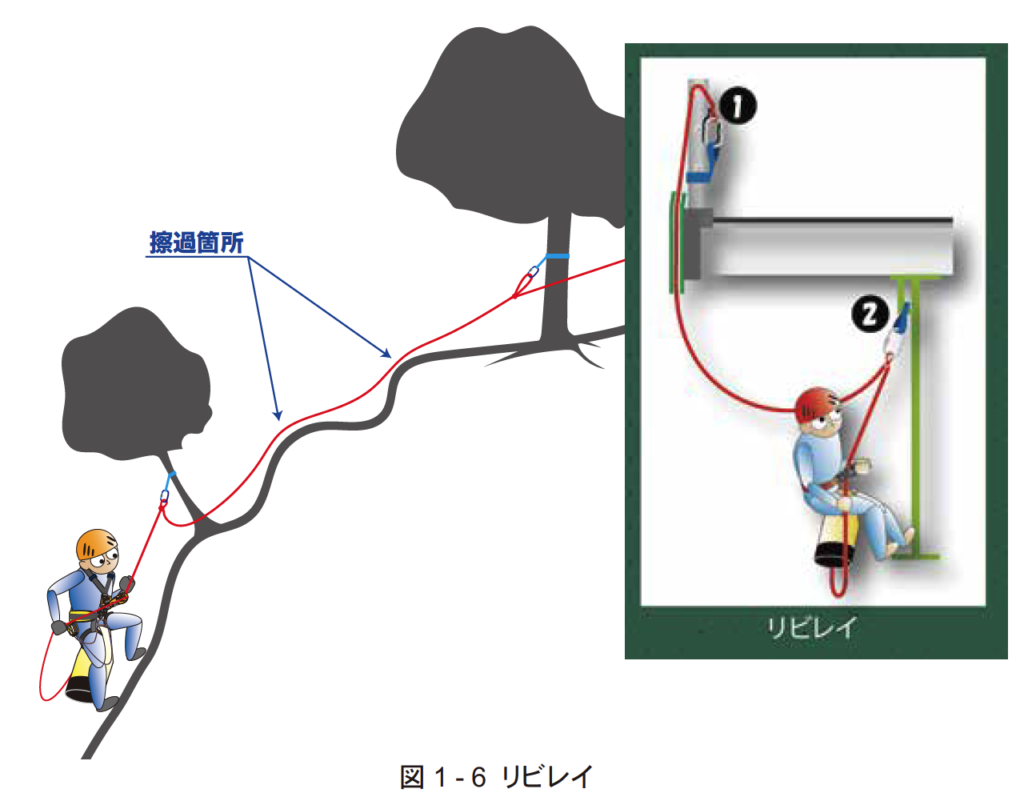
Rebelay refers to establishing a new anchor point during descent and transferring the load to that anchor point.
When there is a possibility that the rope may rub against an edge (sharp corner, rock edge, etc.), by transferring the load (rope worker’s body weight and other weights) to a rebelay anchor point below the rubbing area, the tension is removed from the rope passing through the rubbing area (creating a slack state in the rope), avoiding damage to the rope caused by rubbing.
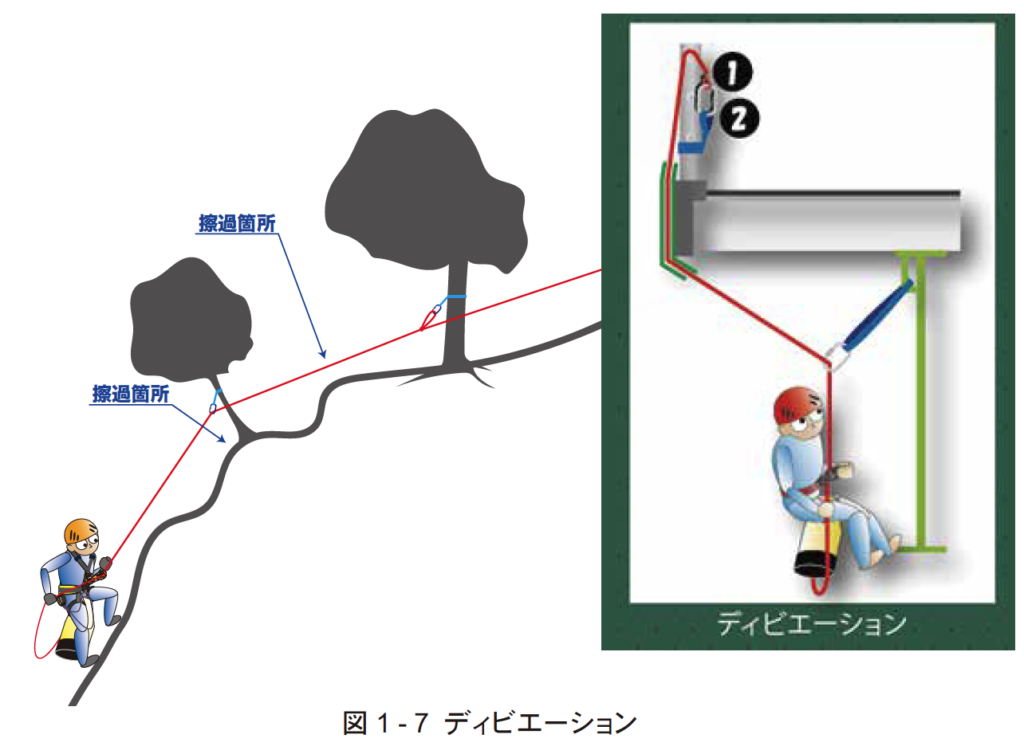
When there is no sufficiently sturdy support (rebelay anchor point) for a rebelay, this is used as a substitute for rebelay. It avoids rubbing by pulling the rope away from the rubbing area.
Unlike a rebelay, with a deviation, the rope is not tied but only passes through a carabiner. The deviation anchor point is established from a wall, tree, etc. on the opposite side of the rubbing area. A sling is extended from the deviation anchor point with a carabiner attached, through which the rope passes.

Also called a rope guard, this is a protective material wrapped around the rope when the rubbing area cannot be avoided with rebelay or deviation.
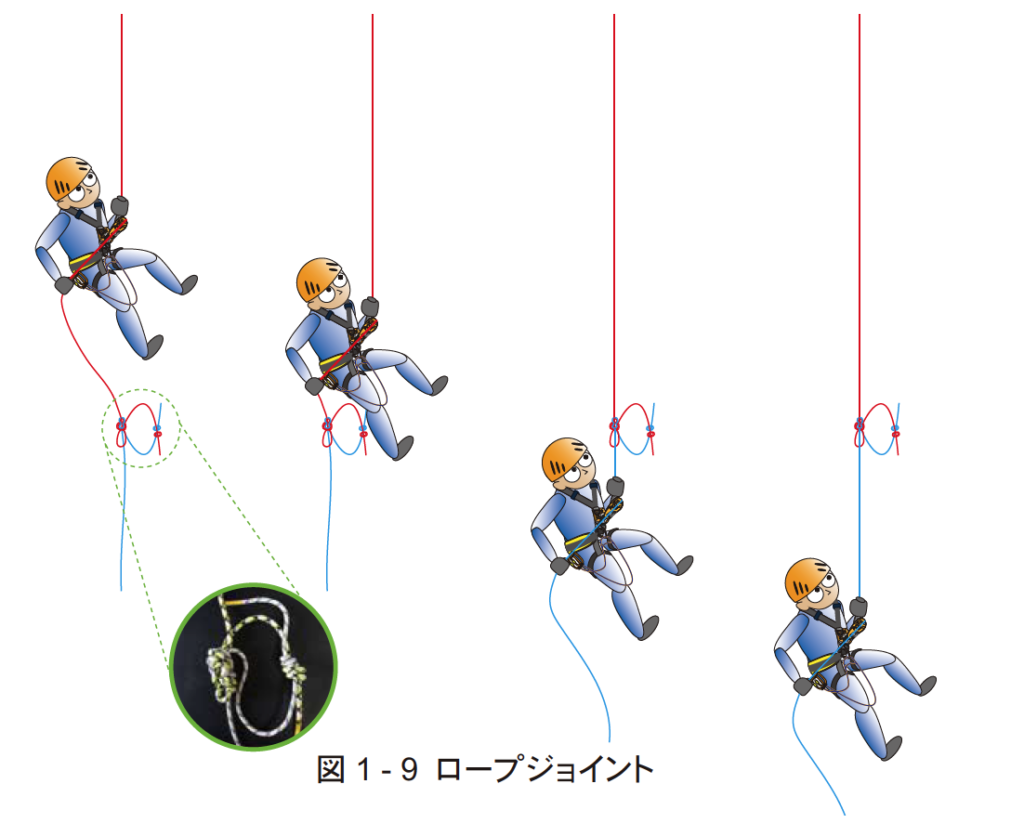
When the rope becomes insufficient during descent, ropes are tied together, and the descent continues past this knot (rope joint).
A backup knot must always be created for the rope joint to prevent falls due to tying mistakes. The “principle of two-point security” mentioned later is thoroughly implemented here as well.

Keystone’s Rope Access Technique [SORAT] is described as a technique premised on ensuring safety, and specifically, the following “3 Principles of Safety Assurance” form its foundation:
◆ Safety Assurance Principle 1: “The Fundamental Principle of Two-Point Security”
◆ Safety Assurance Principle 2: “Operation Check”
◆ Safety Assurance Principle 3: “Dummy Load Test”
It is not an exaggeration to say that safety assurance is perfect if one can reliably implement the above “3 Principles of Safety Assurance” “absolutely in any situation.”
◆◇◆ 30 Years of Safety Performance – Thanks to you, Keystone has had no accidents since its founding ◆◇◆
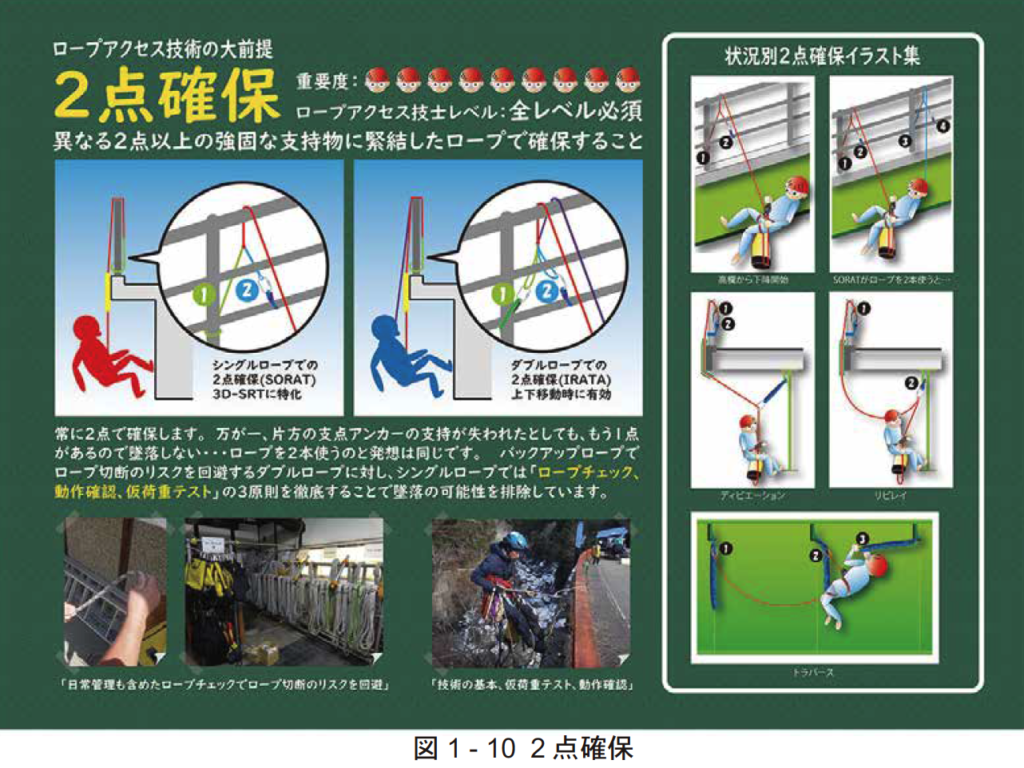
Always secure yourself with a minimum of two points. The fundamental principle is that if one anchor point fails, the other anchor point remains, preventing a fall.
This “premise of 2-point anchoring” can be positioned as a safety principle that “exceeds” the concept of lifelines mandated by the revised Occupational Safety and Health Law (for rope-based height work).
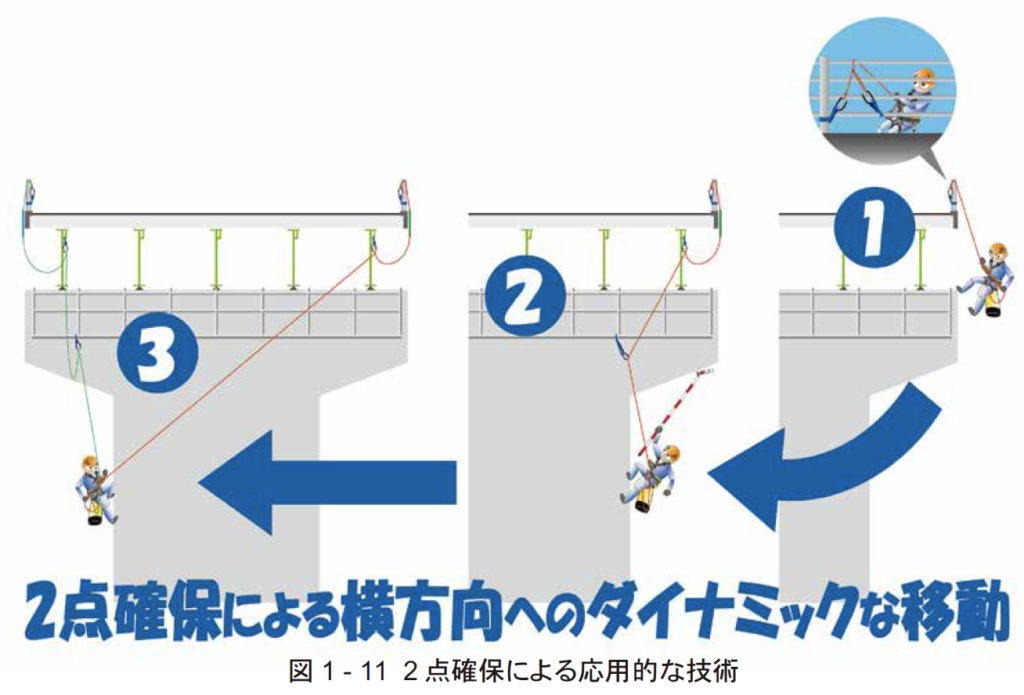
With 2-point anchoring as the fundamental premise, unique rope techniques have been independently developed and continue to evolve daily, allowing for quick and flexible three-dimensional movement.
An operational check is one of the three fundamental safety principles, which involves checking and confirming that descenders and ascenders with ropes installed are functioning properly every time ropes are set up.
Through this operational check, you confirm there are no mistakes in rope installation on equipment and that there is no twisting in carabiners.
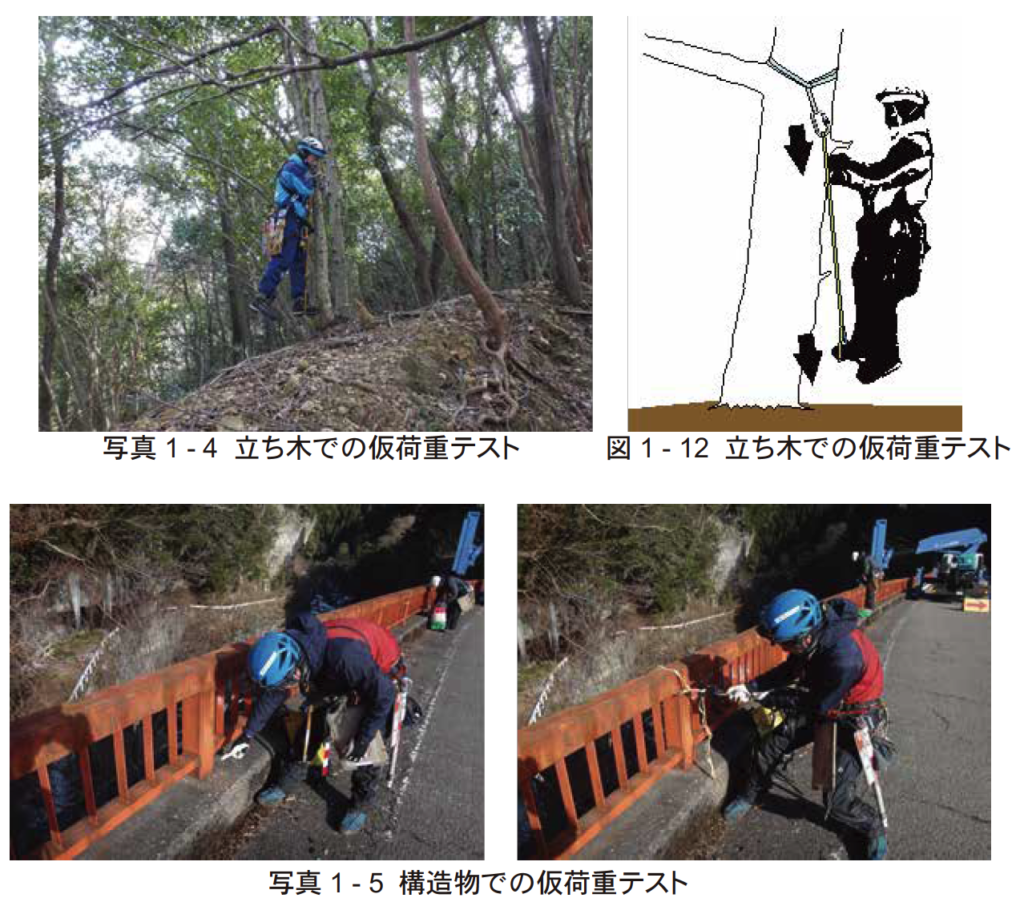
Test loading is one of the three fundamental safety principles, which involves temporarily placing your full body weight on an anchor point to check and confirm it is sufficiently strong whenever setting up anchor points, such as when beginning a descent or at a re-belay point… after first ensuring your safety.
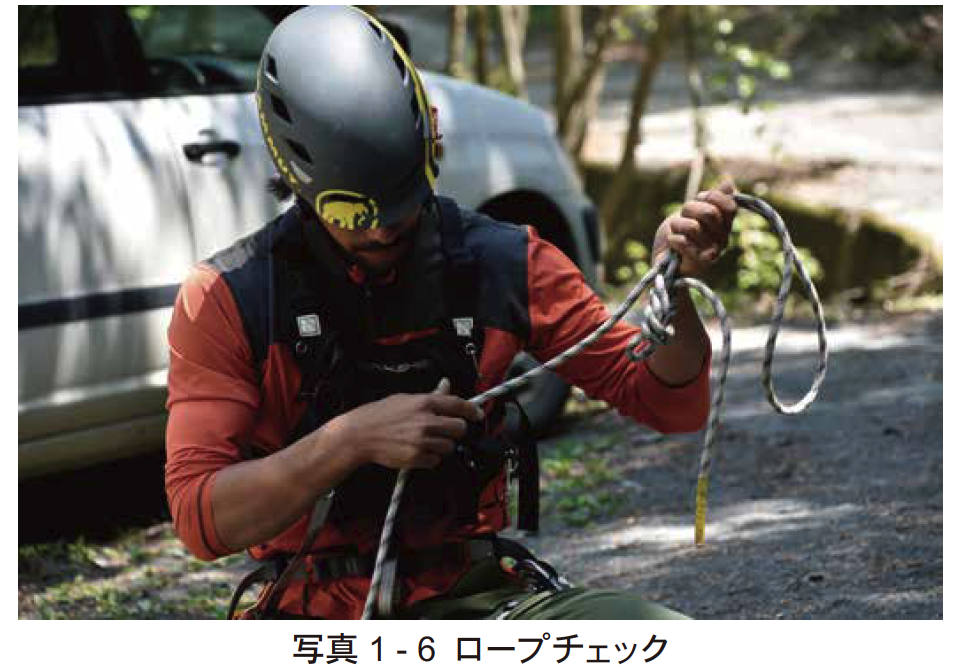
A rope check involves checking whether ropes have sustained any damage. This is done not only during routine maintenance but also repeatedly at the worksite every time ropes are taken out of or put into rope bags, checking for damage through touch and visual inspection. If damage is found, the rope is immediately discarded.
This check eliminates the possibility of ropes being worn out and potentially breaking.
Photo 1-5 Temporary Load Test on a Structure
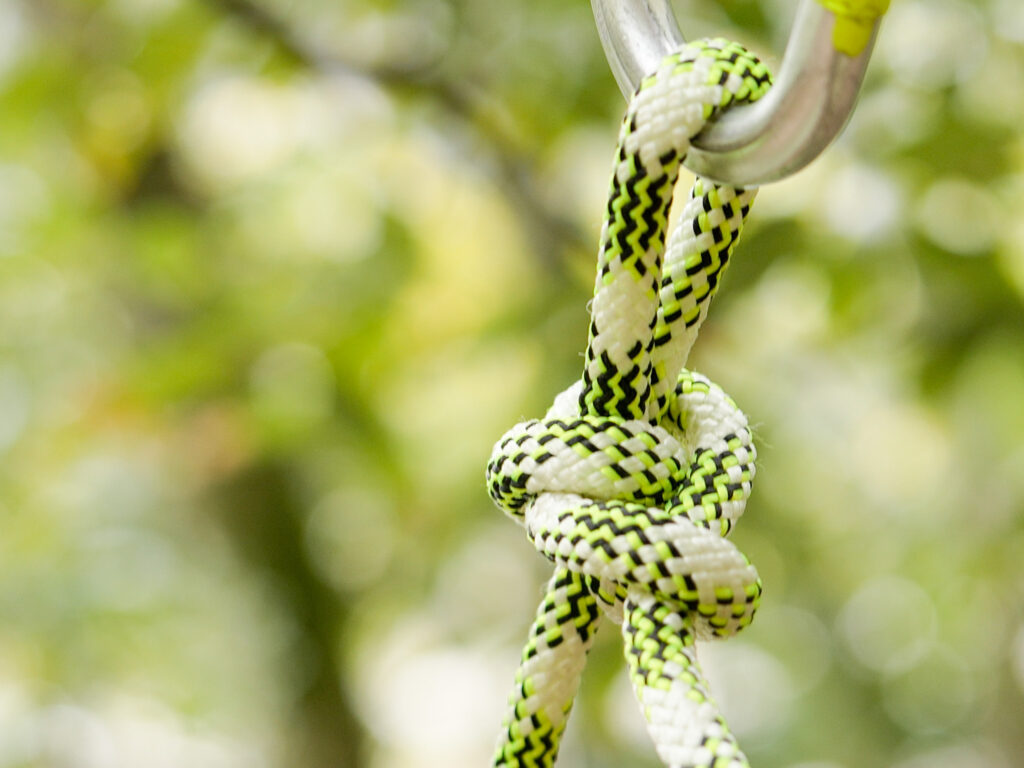
“People often worry and ask, ‘Will the rope break?’ but it’s fine. With our method, it won’t break.”
The possibility of a rope breaking mainly occurs when one or a combination of the following three factors is present:
1) The load on the rope is too great, causing it to break.
2)The rope is damaged, causing it to break.
3) The rope rubs against sharp edges, causing it to break.
Against these possibilities, Rope Access Technique [SORAT] implements the following thorough countermeasures:
1)The load on the rope is too great, causing it to break.
Countermeasure 1: The strength of the rope used is sufficient, equivalent to a safety line, and can withstand weights of up to about 2 tons.
2) The rope is damaged, causing it to break.
Countermeasure 2: Rope checks are diligently conducted daily, before and after use, and if any damage is found, the rope is discarded.
3) The rope rubs against sharp edges, causing it to break.
Countermeasure 3: To prevent the rope from touching sharp edges, rope techniques such as rebelay and deviation are used to control the rope’s passage position, or the rope is protected with rope guards.
In this way, Rope Access Technique [SORAT] reduces the possibility of rope breakage to zero through these thorough countermeasures.
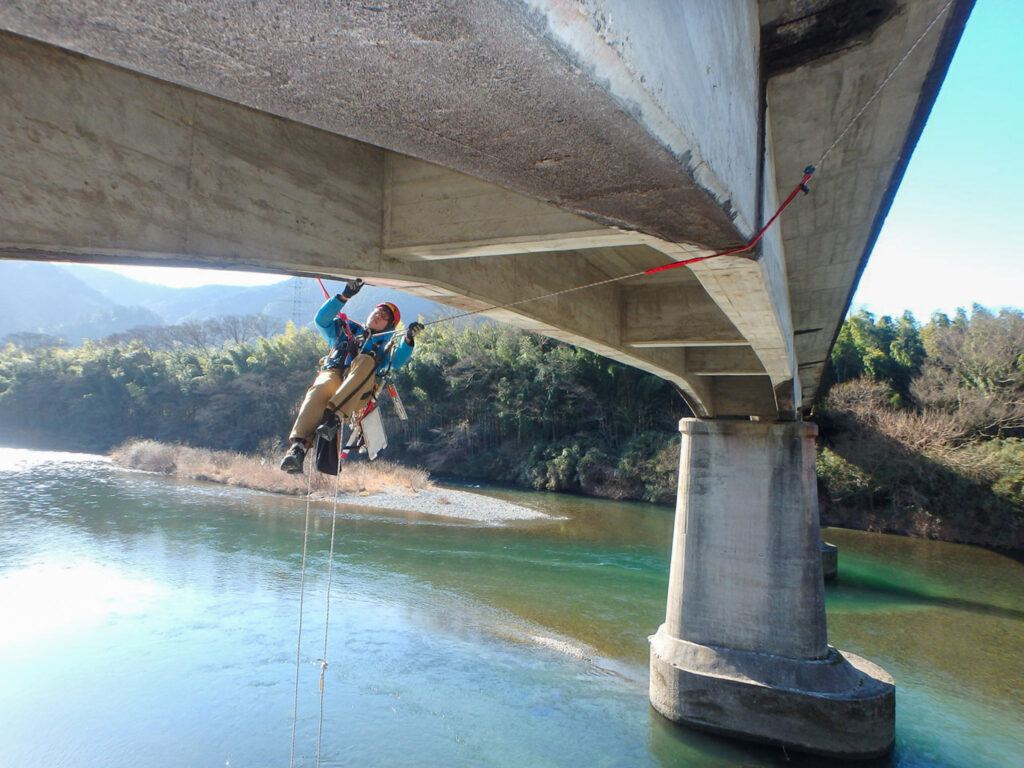
This section introduces Keystone’s unique techniques frequently used in bridge inspections with rope access technique. These techniques continue to evolve (deepen) daily with absolute safety as the fundamental premise.

This is a basic technique for rope access bridge inspection. Anchor points are created on elements that can support slings, such as suspension brackets, main girder web scallops, and lateral members, allowing inspectors to move horizontally while transferring from one point to another for inspection.
There are two types of traverses: “Solo Traverse,” where one person establishes anchor points and removes them while progressing, and “Two-Person Traverse,” where a team of two works together with the lead inspector creating anchor points and the following inspector removing them as they progress.
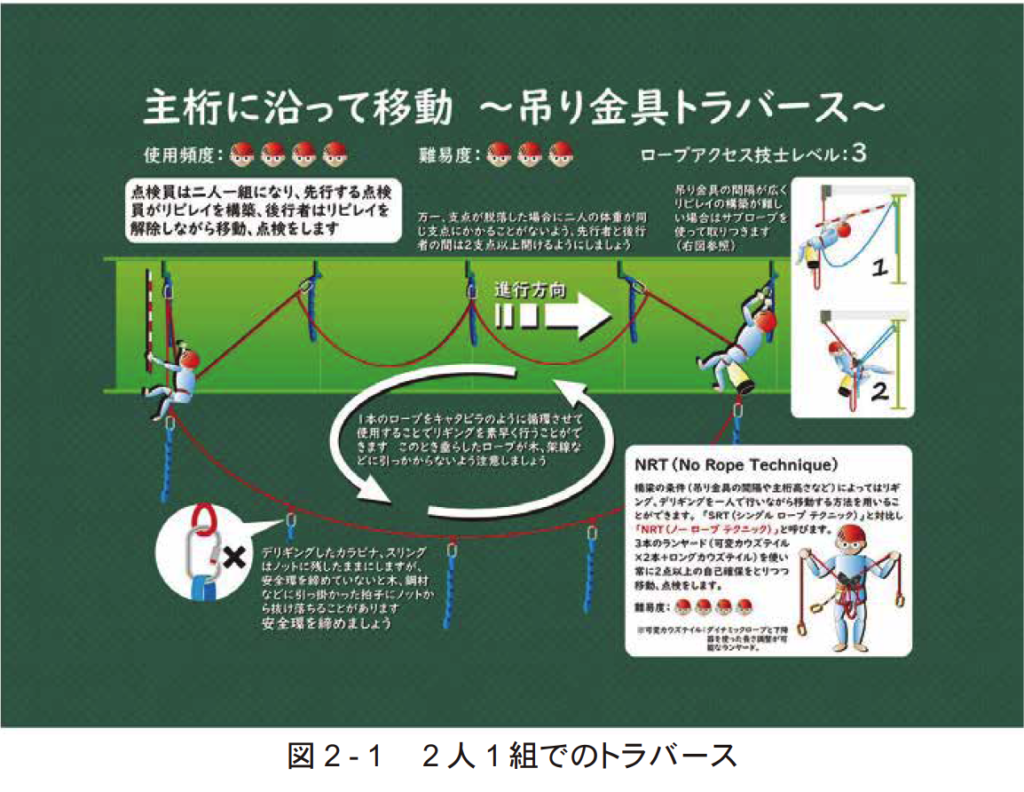
The speed of progress (inspection) is faster with the Two-Person Traverse, but the number of worker-hours required to inspect the same area doubles. In most cases, Solo Traverse is more economical, but depending on the shape of main girders and cross beams, there are situations where one person cannot progress alone. The optimal method is adopted for each site.
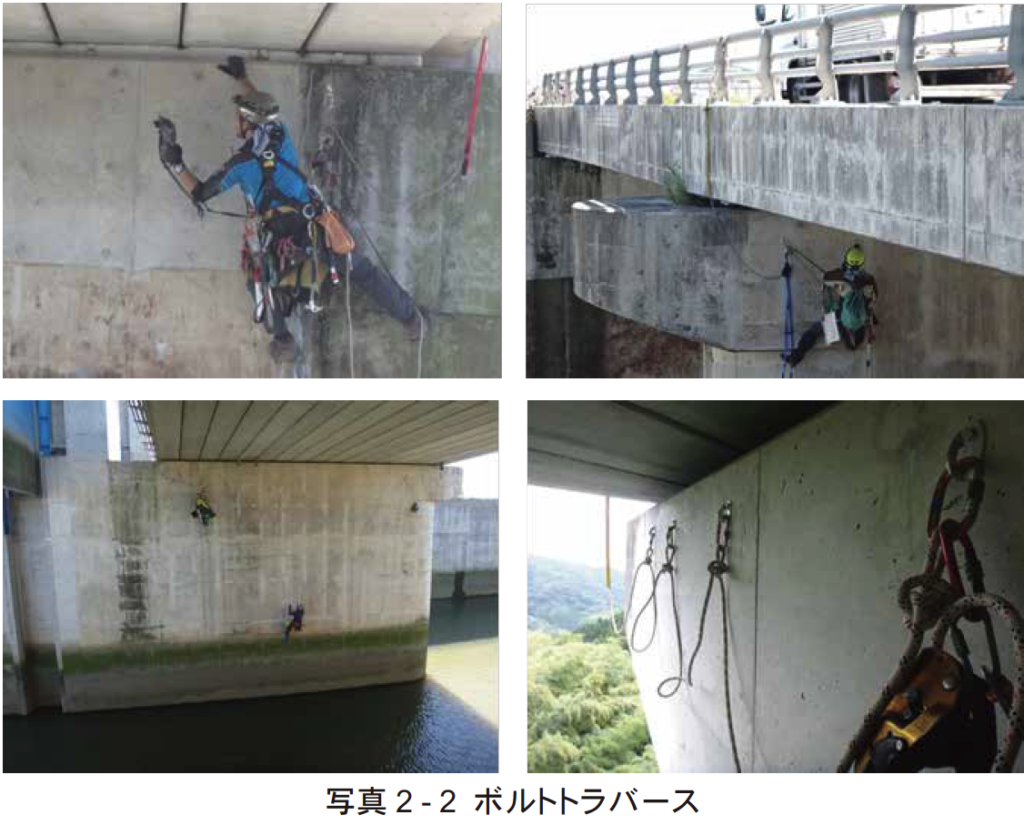
This is a technique used when there are no structural elements in the desired direction (for inspection) to serve as anchor points. Bolts are installed into the structure to create anchor points while traversing.
The inspection speed is slower compared to normal traversing due to the extra work required for anchor installation.

This is a technique for three-dimensional movement using multiple ropes attached to different anchor points and multiple descenders (ascenders).
It is essential for pier inspections as it can cover a wide area in a single descent.
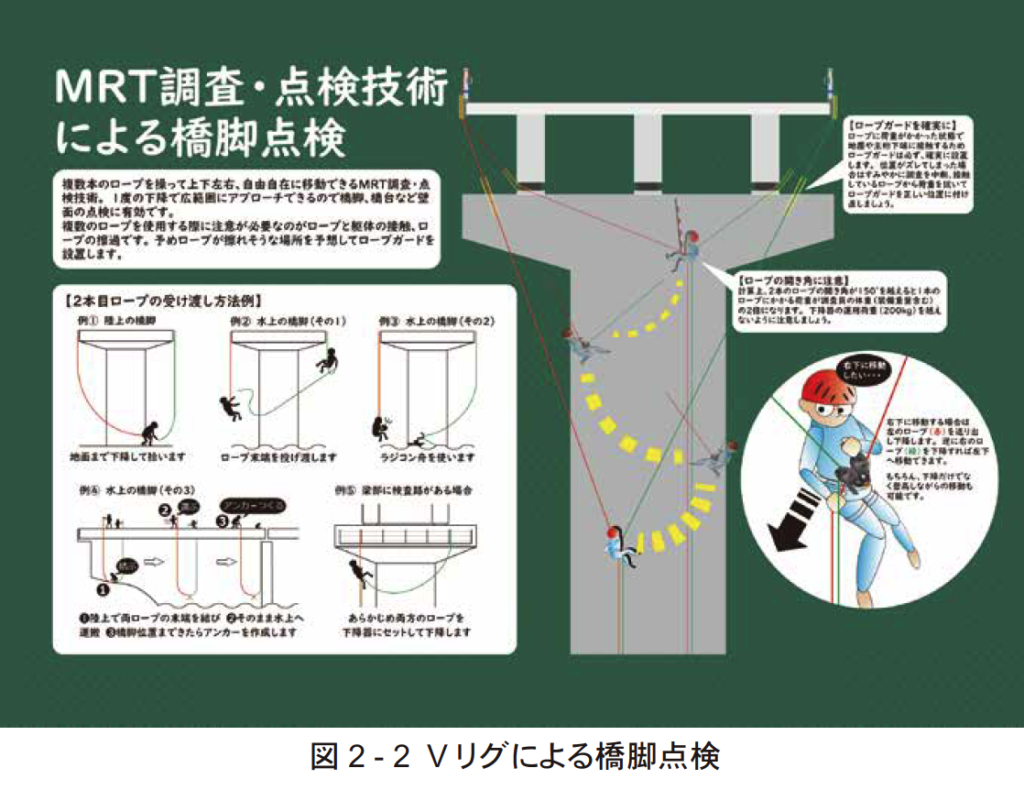
(Figure 2-2 Pier Inspection with V-Rig)
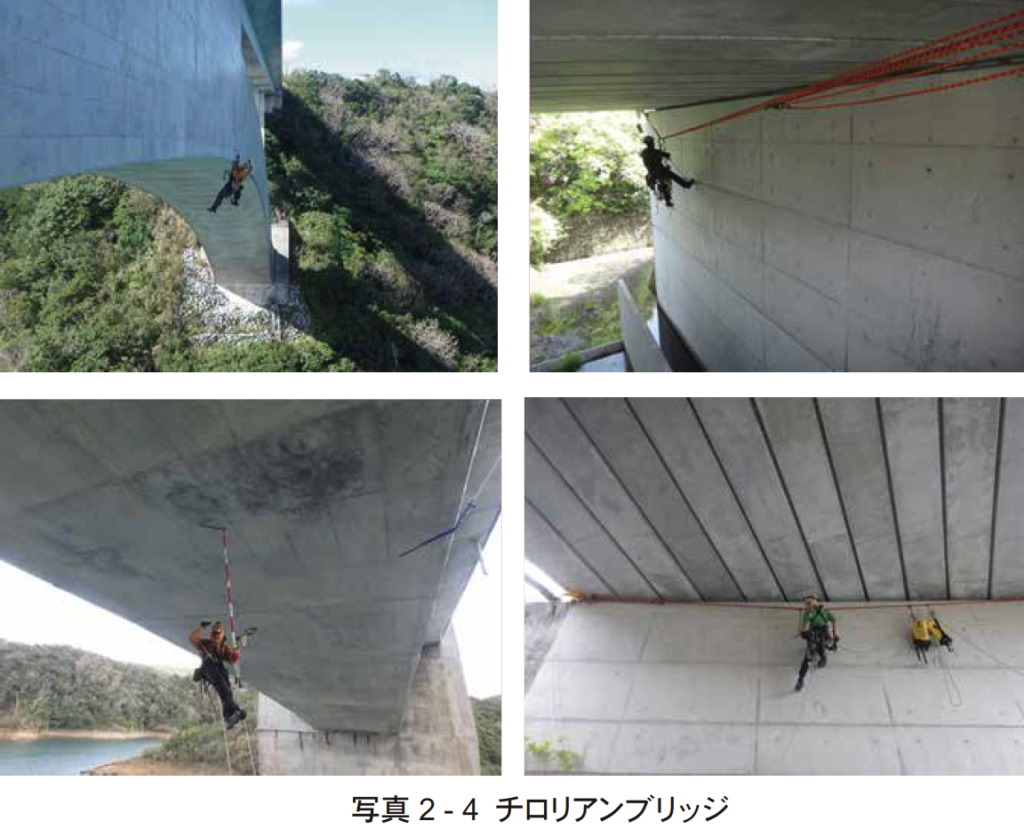
This is a technique for horizontal movement by hanging from a pre-tensioned rope.
It is effective for movement and inspection in situations where anchor points cannot be established, such as in PC slab bridges.
It can accommodate distances of up to about 20m between anchor points.
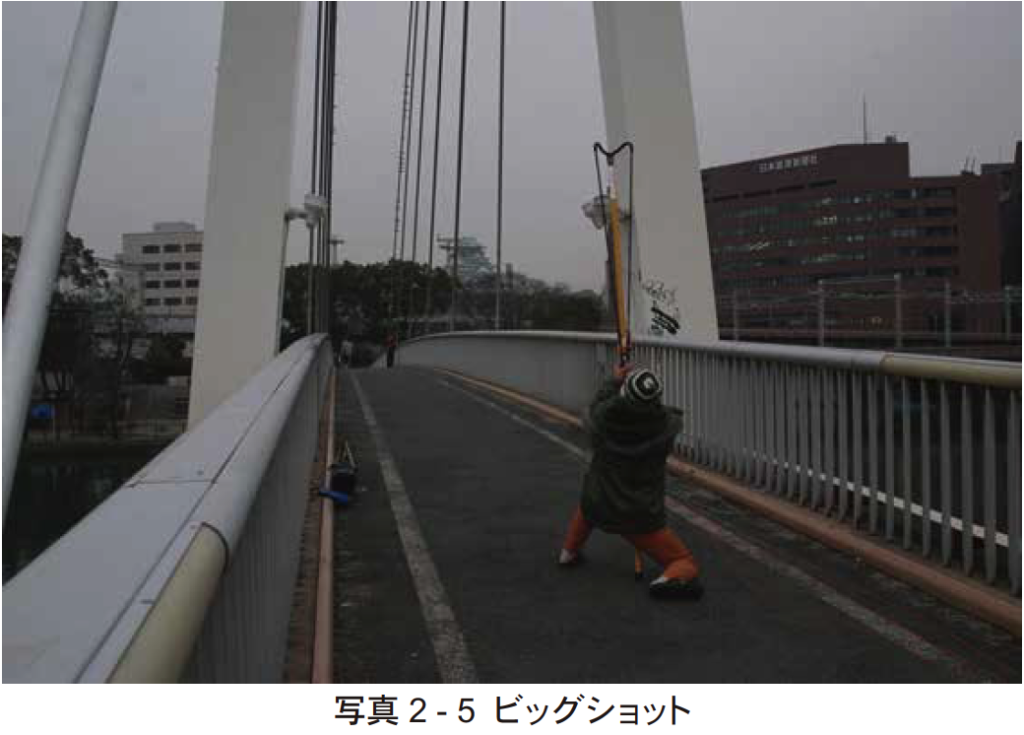
For inspecting cable-stayed bridges and suspension bridges, the key point is how to approach the top of the main tower.
If the tower itself has climbing facilities, there is no problem, but most cases do not have such facilities. Keystone has devised and implemented methods to reach the top of the main tower safely, quickly, and reliably.
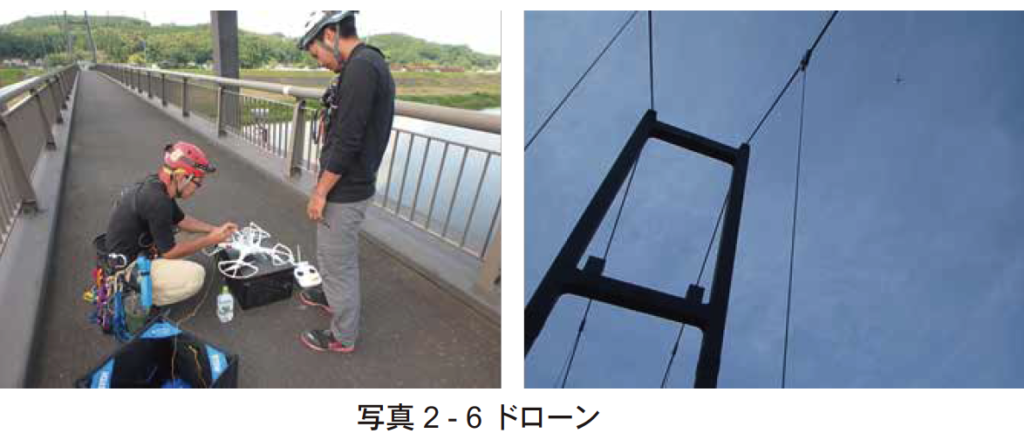
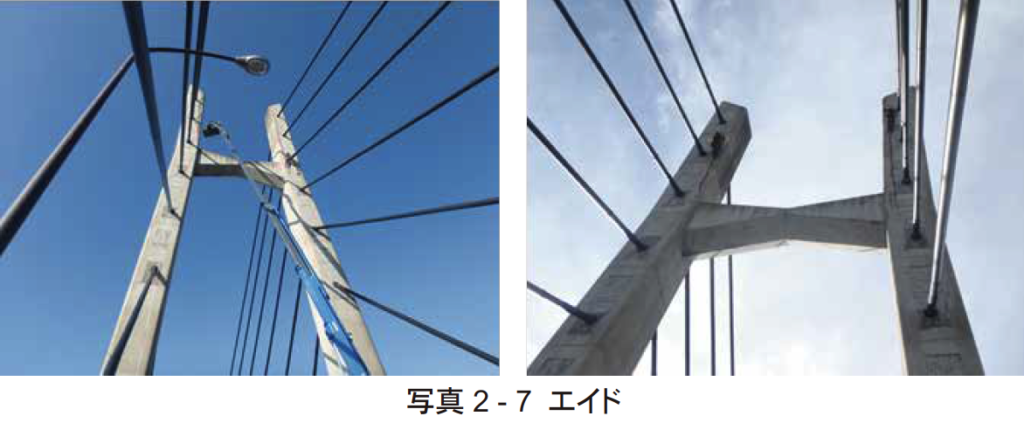
(Photo 2-6 Drone)
(Photo 2-7 Aid)
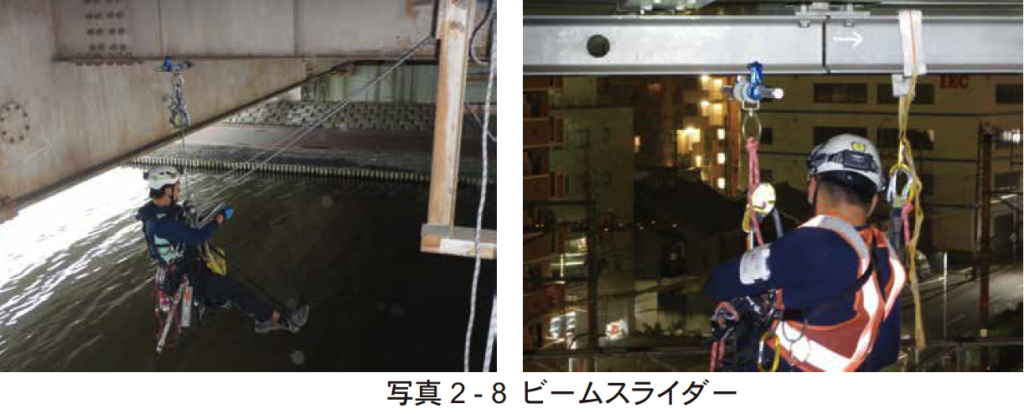
Regarding traversing using beam sliders: Beam sliders are installed on the lower flange of main girders, cross beams, or stringers and used as one of the anchor points when there are no components such as suspension brackets that can serve as anchor points.
When the width of the lower flange changes or when the end is free (when there is a gap between it and other steel materials), there is a possibility of slipping out, so sufficient knowledge and caution are necessary for operation. With beam sliders, the speed of movement (traversing) increases significantly.
They are also becoming essential equipment when anchor points as mentioned earlier cannot be established.
However, since they are installed on the lower flange, the position of the inspector will be below the lower flange. In cases where the girder height is high, this is a position that does not allow close access to the deck.
If movement is possible but close access is not… it cannot be used for inspection. Operation must be considered with appropriate placement in mind.
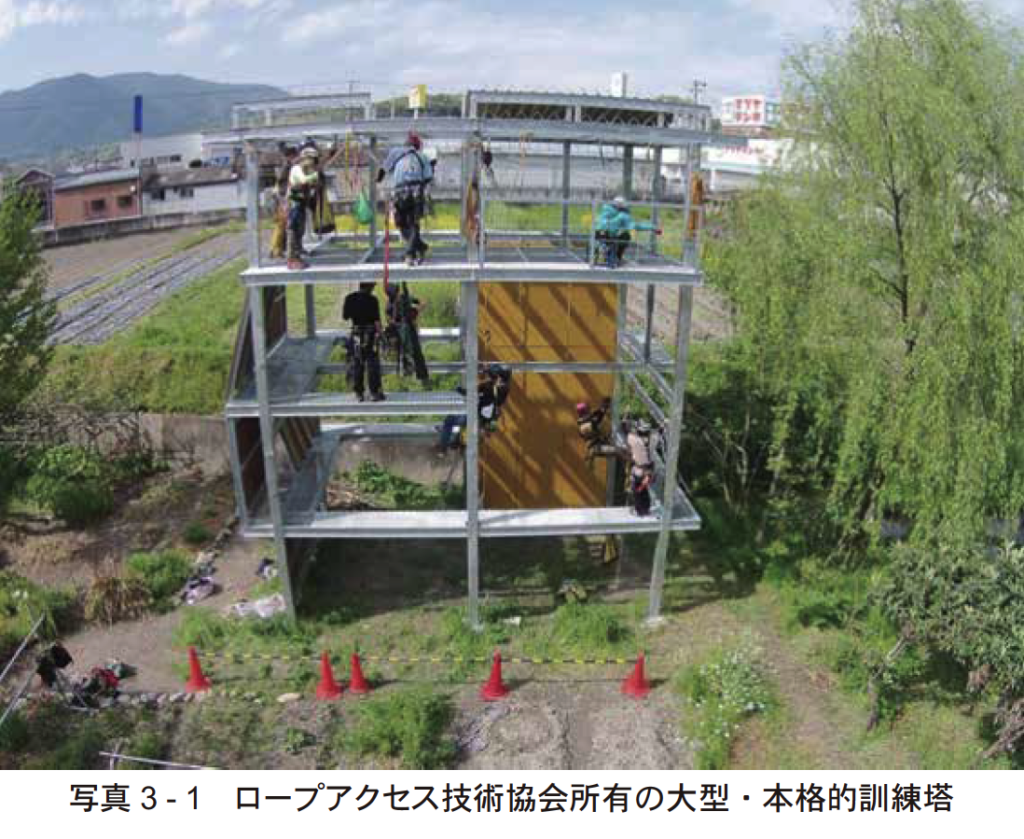
Rope Access Technique [SORAT], as explained in the previous “About the Technique” and “About Safety” sections, is an established technique and is safe when practiced correctly.
However, it is difficult to completely separate any technique from the risk of accidents. Due to the nature of accessing high or difficult locations, there may be situations where accident victims are in locations that can only be accessed by rope access technicians.
It is necessary to have the ability to transport accident victims by your own means (investigation team members) to a location that public rescue agencies (fire department, police) can reach.
Keystone’s Rope Access Technique [SORAT] implements safety measures by mandating rescue training sessions several times a year.
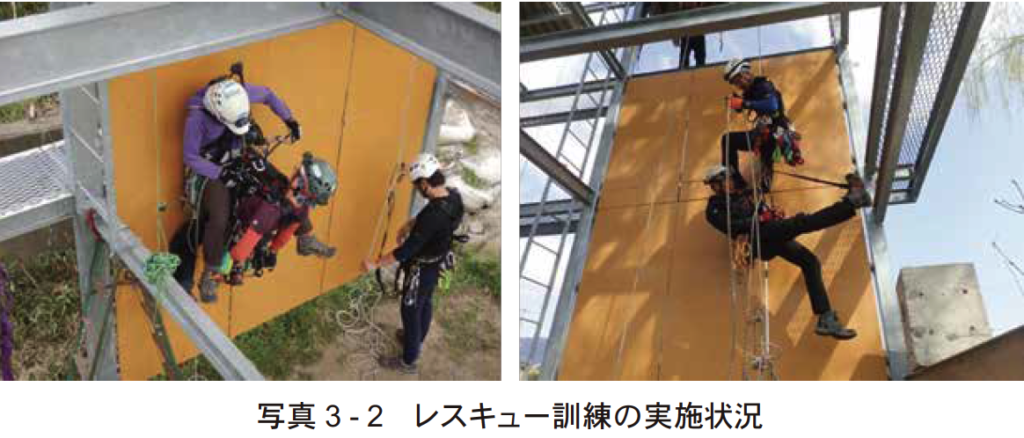
Also, in anticipation of an accident, information about emergency contacts and surrounding medical facilities is collected in advance.
In the event of an accident, rescue and other responses are performed as necessary, and prompt medical attention is required.
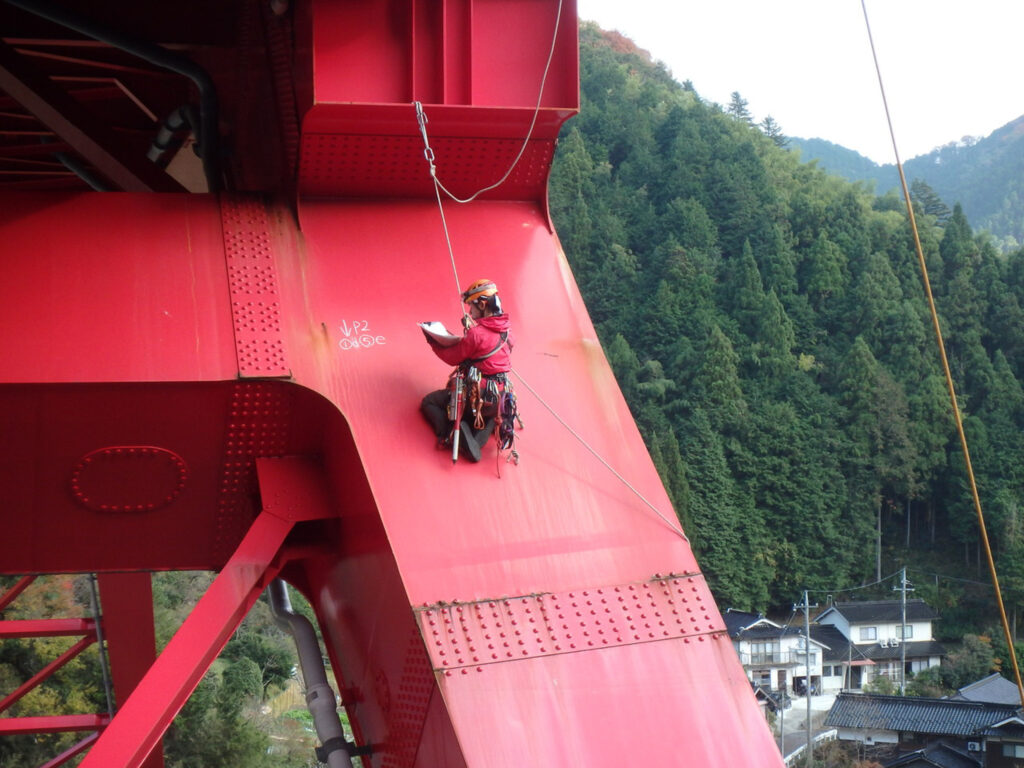
Rope Access Technique corresponds to “Rope High-Place Work” in the revised Safety and Health Regulations (enforced in 2016).
(1) Definition of Rope High-Place Work (relating to Article 539-2)
The definition of Rope High-Place Work is “work performed by workers who maintain their bodies using ascending/descending equipment (devices that allow workers to ascend or descend by their own operation, which are suspended by fastening ropes to supports above the work area and attaching devices that support the worker’s body to these ropes) at locations with a height of 2 meters or more where it is difficult to establish a work platform (excluding work on slopes of less than 40 degrees).”
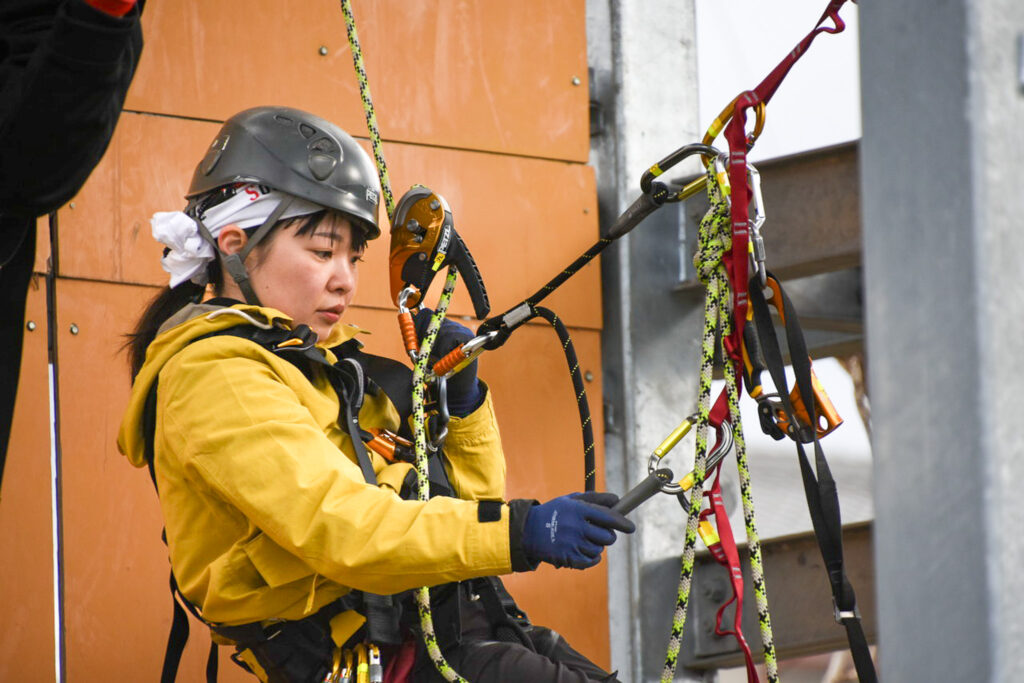
In addition, investigators engaged in this work need to have completed “Special Education for Rope High-Place Work.” All investigators at Keystone have completed “Special Education for Rope High-Place Work.”
The content of theoretical education and practical training for special education for workers engaged in rope high-place work is specified as follows (relating to Article 23):
(Theoretical Education)
(1) Knowledge about Rope High-Place Work: 1 hour
(2) Knowledge about Main Ropes, etc.: 1 hour
(3) Knowledge about Prevention of Occupational Accidents: 1 hour
(4) Related Laws and Regulations: 1 hour
(Practical Training)
(5) Methods of Rope High-Place Work, Measures to Prevent Occupational Accidents Due to Falls, and Handling of Safety Belts and Protective Helmets: 2 hours
(6) Inspection of Main Ropes, etc.: 1 hour
With the revised Safety and Health Regulations (enforced in 2016), “Rope High-Place Work” was defined, and the “Installation of Lifelines” was mandated.
Within this, there is an item related to “Transitional Measures,” and “Rope Access Technique” covers this part. The content of the transitional measures is as follows:
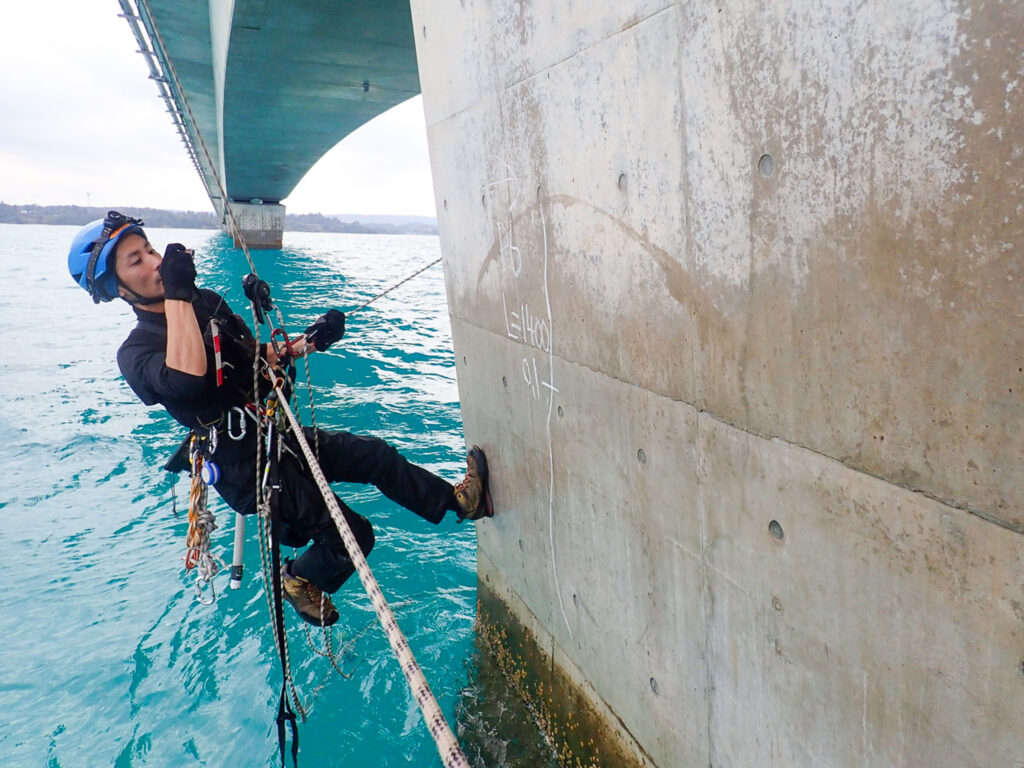
For rope high-place work other than work related to building cleaning services or slope protection construction (such as surveys, inspections, and examinations of bridges, dams, wind power generation, etc.), the provisions of “Installation of Lifelines” will not apply for the time being, only if measures ① and ② are implemented:
① Securing the main rope to two or more different sturdy supports ② Taking measures to avoid contact between the main rope and areas where it might be cut (Deviation). When this is difficult, in addition to ①, re-securing the main rope to a sturdy support below that area (Rebelay).
In other words, at survey and inspection sites, there is an exception stating that lifeline installation is not necessarily required if safety measures such as two-point security, deviation, or rebelay are implemented.
We sometimes receive questions like, “Why does Keystone perform rope access work with just one main rope, without using a lifeline?” There are two reasons for this.
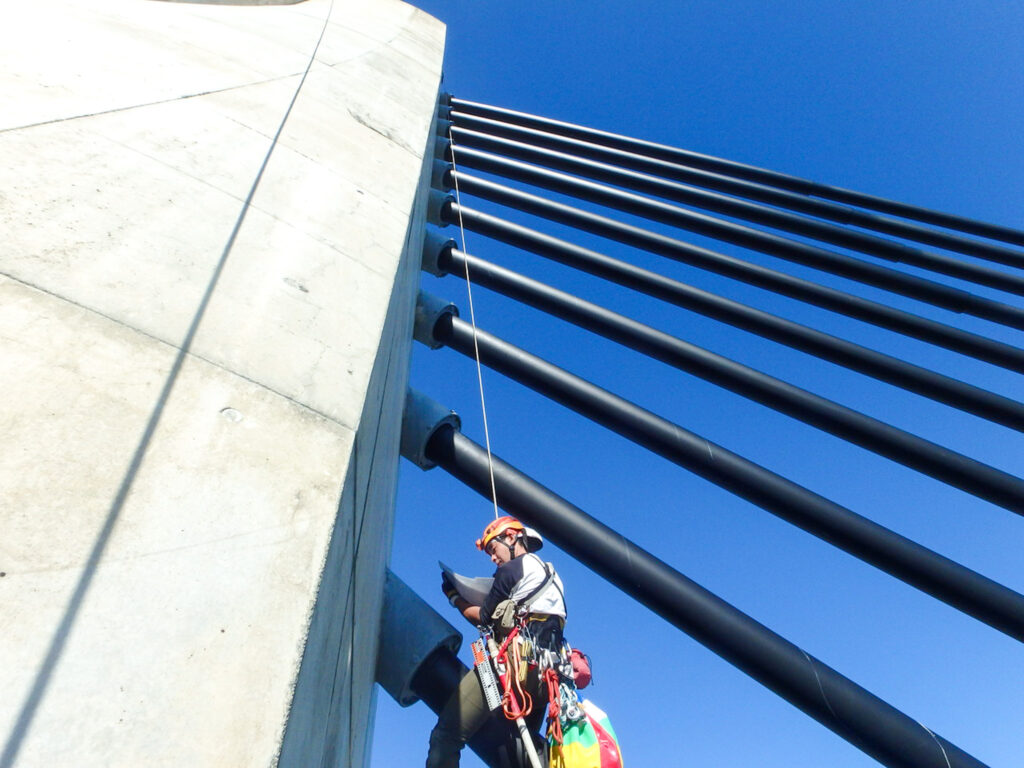
In many cases, installing a lifeline is difficult due to the nature and constraints of the work. At Keystone’s specialized survey, inspection, and examination sites, there are not a few cases where lifeline installation is impossible or difficult, or even meaningless if forcibly installed.
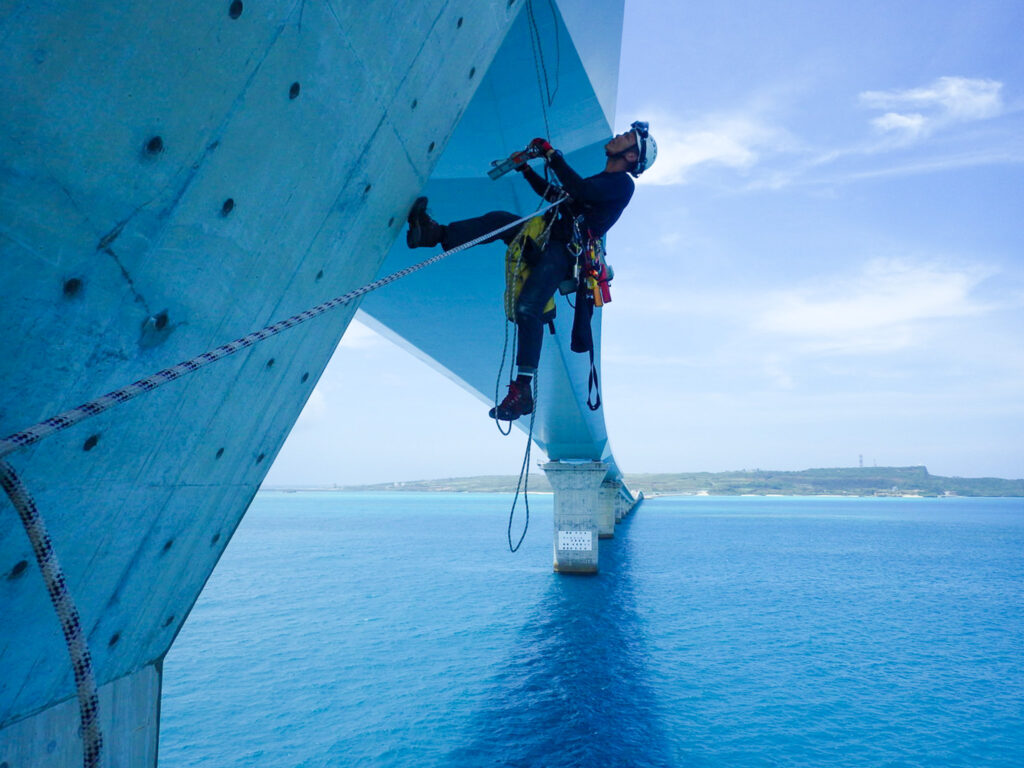
As a “transitional measure,” the revised Safety and Health Regulations recognize cases where lifelines do not need to be installed.
The “transitional measures” state that, limited to survey, inspection, and examination work, lifelines do not need to be installed provided that the following conditions ① and ② are met:
Condition ①: Securing the main rope to two or more different sturdy supports.
Condition ②: Taking measures to avoid contact with areas where the main rope might be cut (Deviation, Rebelay).
For these two reasons, since Keystone frequently handles survey, inspection, and examination work, based on the provisions of the revised Safety and Health Regulations, by implementing appropriate measures, we often do not necessarily install lifelines.